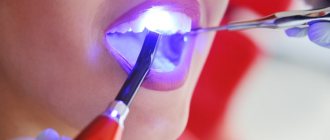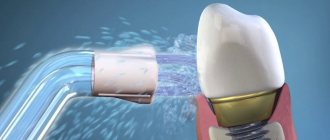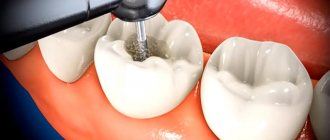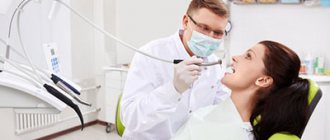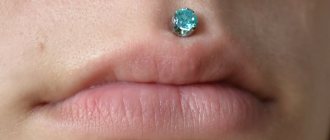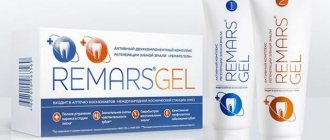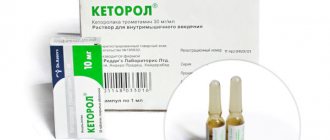How much can you not eat after having a filling installed?
All patients are interested in whether they can eat after having a filling installed.
You can eat food, but not immediately after the event, but after some time. Experts use various compositions, and each of them has its own hardening time. But first, you need to consider what you can’t eat after installing a filling in order to avoid its premature destruction.
The list of prohibited products includes all solid products, including chips and crackers, viscous - toffee and other products of similar consistency, coloring - coffee and tea, tomatoes, beets and the like. The consumption of hard and viscous products contributes to the destruction of the filling, and the use of coloring products causes a change in the color of the filling material.
Temporary restrictions
The first question that patients ask the doctor after treatment is: how long can you not eat? It all depends on the technology used, and some of them allow you to eat food almost immediately.
But there is one caveat. Even if the top layer has already hardened, the inner layer is subject to deformation. Therefore, there is no need to rush. There are the following general recommendations on time limits (according to the type of material):
- amalgam – 3 hours;
- plastic – from 3 to 5 hours;
- cement - from 2 to 3 hours;
- photocurable composites – can be eaten immediately;
- chemically cured composites – 1 hour;
- temporary fillings except photopolymer ones – from 2 to 3 hours;
- photopolymer temporary fillings – no restrictions.
What are the types of fillings and fillings?
Many patients are asked: “What fillings do you want to get?” And in order not to get into an awkward position, you need to understand what kind of fillings exist.
Keep in mind! In dentistry, they differ in composition and use:
- Plastic and ceramic. Plastic ones are the most popular because they are considered cheap and quick to install. Ceramic ones are harder and more reliable.
- Amalgam fillings. They contain silver, copper, zinc, mercury or tin. They are considered ductile, have high strength and can last for several years.
- Temporary and permanent. Temporary ones are used for long-term treatment, and permanent ones are used for instant treatment at a time.
Note! Modern medicine provides several types of materials for tooth filling.
Their main goal is to restore all processes. The material must be selected for the appropriate load:
- Filling of front teeth. Most often, teeth are destroyed due to caries in the front row. This procedure has its own indicators. To avoid future problems with chewing food, a specialist installs light-curing material.
- Filling using paste. Doctors quite often use pastes in their work. They are needed to seal the void after the inflamed pulp has been removed.
- Innovative filling. Such methods include canal sterilization, the use of hot or cold gutta-percha, mummification and retrograde filling.
Is it possible to drink after having a filling installed?
At the appointment, patients always ask whether they can drink tea or other drinks after treatment. In this case, the same recommendations apply as for eating - it all depends on the technology. But there are also additional restrictions. Drinking drinks is not recommended until the anesthesia effect has completely subsided.
This is due to the possibility of injury to the mucous membrane by too hot a liquid, because sensitivity is reduced. It is very difficult to say exactly how long you can drink. In this case, everything depends on the effectiveness of the painkiller, its duration of action, dosage and individual reaction of the body.
Recommendations
Immediately after installation, you must refrain from drinking and eating for the time recommended by the dentist until the final effect of the pain medication. After this period, you should not eat foods that are too hot or too cold, as they may affect the strength properties of the material.
The load should be moderate. It is advisable to try not to chew on this side of the jaw during the day, since the filling may become loose if it does not harden sufficiently.
In addition to traditional questions about food and drink, dental visitors are also interested in additional questions.
Is it possible to drink alcohol
In fact, alcohol does not have any special effect, which means that theoretically it can be consumed. But the point here is completely different. In most cases, filling is performed under anesthesia, and it and alcohol are incompatible. Therefore, experts recommend abstaining from alcohol for at least a day.
The same can be answered to the question “can I drink beer?” After 24 hours, yes, you can. Beer does not contain coloring enzymes and fillings do not change color under its influence.
Is it possible to smoke after installation?
After the filling procedure, you can smoke approximately 2-3 hours later.
. Tobacco smoke does not affect the color of the filling, unless it concerns plastic-based compounds. They are rarely used due to their fragility, but when using such a composition, smoking immediately after the procedure will cause its darkening. Ideally, dentists recommend giving up cigarettes for at least a day, if possible.
When can you smoke?
Removing each tooth will require qualifications and skill from the doctor. If we are talking about pulling out wisdom teeth, the greatest skill will be required.
Difficulties arise during the operation:
- The root is wide or curved;
- Large tooth sizes;
- Removal in small parts.
In case of severe damage, teeth are removed in parts. The dentist gives recommendations that must be followed to avoid complications.
After tearing it out, a wound remains. A swab soaked in an antiseptic is placed on the wound. This is necessary for blood clotting. The tampon remains in the mouth for fifteen to 20 minutes.
After time has passed, the tampon is removed. It must be removed carefully, trying not to damage the blood clot formed on the wound. The clot helps the wound heal.
To avoid infection, the patient is prescribed antibiotics. It is impossible to combine taking antibiotics and cigarettes without risk to health. If a person suffering from heart disease has undergone surgery, then taking antibiotics and smoking are prohibited.
After removal, it is better not to smoke until the wound heals. If it is difficult for a smoker to hold out for this time, smoking should be postponed for at least 2 hours, provided there is no bleeding. When stitches are applied to the wound, the period increases to 10 days.
What not to do after installation
The main thing that should not be done after installation is to subject the tooth to increased loads.
. Therefore, gnawing any foods (nuts, seeds, candies, etc.) is highly discouraged. Avoid the use of chewing gum, toffees and other similar confectionery products that tend to stick to teeth.
The consumption of hot and cold foods is limited; this can cause the filling material to break prematurely.
There should be no traumatic impact on the tooth, therefore, if discomfort is felt, you should consult a doctor and not take any action yourself.
Is it possible to brush your teeth
A specialist will definitely advise you on how to brush your teeth after installing a filling. It is advisable to do this only the next day. In some cases, it is recommended to change the paste and brush. It is better to choose a brush of medium softness; it will not injure the injection site. Pastes - on the recommendation of a doctor, but without the inclusion of abrasive components.
Recommendations after installing a light seal
Photopolymer is a new material that instantly hardens under the influence of a solar lamp.
Has high strength characteristics. It is possible to select a shade that best matches the natural one. After installation, such a filling is not visible even on the front teeth.
Care
Caring for teeth with polymer fillings is not particularly difficult:
- they need to be cleaned regularly, with a medium-hard brush and gel toothpastes that do not contain abrasive inclusions;
- Dental floss should be used carefully; if it clings to the edge of the filling, you should immediately contact a specialist to eliminate this defect;
- exclude coloring foods from your diet for at least a week;
- limit the consumption of sweets, including sweet carbonated waters, especially those with dyes;
- For several days after the event, do not load the tooth and limit yourself to solid food.
Is it possible to eat after having a light filling installed?
The photopolymer hardens instantly, but the inner layer does not have sufficient strength for some time. Therefore, a reasonable question arises: “when can you eat?”
Although many doctors allow you to eat food immediately after the event, it is better to refrain from eating for a couple of hours. There is a risk of material deformation.
There is also the possibility of staining, so you need to consider what not to eat.
Foods that can stain the filling are completely excluded from the diet for 7 days. These are any drinks with dyes, including strong tea and coffee. Fruits and berries with a likelihood of such an impact (cherries, sweet cherries, mulberries, blackberries, raspberries, black currants and the like). Vegetables such as carrots and beets. It is worth giving up tomato-based ketchups and sauces, tomatoes themselves in any form, and a number of juices. Dentists recommend following a “white” diet during this period. That is, eat only what cannot stain the filling.
After installing a temporary filling
A temporary filling is necessary for multi-stage treatment, which involves access to the cavity after several days or weeks. Therefore, the strength and aesthetic requirements for such materials are low. But in any case, you must adhere to the specialist’s recommendations, otherwise the filling will fall out, pathogenic microbes will enter the cavity and the procedure will have to be repeated.
After installation of a temporary filling, patients are interested in the ability to eat and drink. These points need to be considered.
Is it possible to drink
If a regular cement filling was used, you can drink after 2-3 hours. If the cavity is closed with photopolymer, immediately after installation is completed. But the point here is not about strength, but more about anesthesia. When exposed to it, sensitivity is minimal, so the patient may not feel the temperature of the drink and injure the mucous membrane. Therefore, you need to drink very carefully, avoid too cold or too hot, and it is better to do this after the painkiller has worn off.
Is it possible to eat
The specialist’s answer depends on the material
. The use of a cement filling involves the same restriction as in drinking: from 2 to 3 hours. With photopolymer, it is absent, but it is not recommended to load the tooth until it has completely hardened, so you will have to abstain from hard foods for at least a day.
Is smoking harmful after tooth extraction?
Wanting to eliminate the discomfort caused by tooth extraction, smokers habitually take up a cigarette. Nicotine allows you to get rid of pain for a short time after a tooth has been pulled out, but after a few hours the unpleasant symptoms increase with renewed vigor. Another reason to quit tobacco temporarily is that it increases blood pressure. The clot is literally “pushed” out of the wound.
Harm of nicotine for the hole
Smoking not only slows down the healing of the socket after tooth extraction, but also provokes bleeding. Nicotine promotes the formation of a forevacuum, which rejects the blood clot. Prolonged regeneration of the mucous membrane is often accompanied by inflammation. Carcinogens contained in cigarette smoke settle on the gums, causing local ischemia and wound suppuration.
Smoking hookah
It is mistakenly believed that hookah is a safe alternative to cigarettes. Proponents of this theory insist that the device is harmless, since its raw materials are of natural origin. Indeed, hookah smoke contains less nicotine and does not contain tar at all, but it contains large quantities of carbon monoxide, which impedes the supply of oxygen to the wound.
The use of hookah is accompanied by a significant accumulation of harmful substances in the body. The hookah mixture is enriched with components such as arsenic, chromium and lead. If a patient smokes a regular cigarette in a few minutes, then he will stay in the hookah room for at least an hour. It has been proven that inhaling chilled smoke for 60 minutes is as harmful as smoking 100 cigarettes.
Is it possible to experience discomfort after treatment?
After the procedure, slight discomfort is present for 14 days - this is normal.
. During this period, it is necessary to eliminate as much as possible the influence of factors that provoke unpleasant sensations - hot and cold foods, sour, spicy and sweet foods. You also need to avoid excessive stress and carry out hygiene procedures with caution.
But if pain occurs after this period has expired, this is a reason to consult a doctor. There are many reasons for this phenomenon, and only a specialist can accurately identify a specific one.
What to do if your tooth becomes sensitive after installing a filling?
If after installation the tooth reacts to cold or hot, but the required 2 weeks have already passed, you need to urgently go to the dentist. The exception is recently treated pulpitis. In this case, increased sensitivity persists for up to a month.
The specialist will conduct a diagnosis and determine the cause of this phenomenon. This could be the consequences of poor quality filling installation, inflammation or similar diseases. The most common cause of pain is the occurrence of repeated caries. In this case, the destruction of the enamel continues.
Why don't doctors allow smoking?
Tooth extraction is a surgical procedure. The level of dental services is excellent. There is no need to endure pain or discomfort - the dentist has effective anesthetic drugs in stock. At this stage, the patient will be required to wait until the anesthesia takes effect.
Since the pain has been reduced to zero, you should not put off going to the doctor. If a tooth is destroyed or rots, it should be removed without delaying the event.
The operation requires a responsible approach to its implementation and subsequent rehabilitation. To avoid possible complications during the recovery stage, you must follow the dentist's instructions.
Doctors do not allow smoking after tooth extraction - the ban is justified. Cigarette smoke contains substances of chemical origin.
When smoking, smoke envelops the oral cavity, entering the wound. Healing occurs more slowly or stops altogether. There is a risk of bleeding.
What causes recurrent caries
Repeated carious lesions of tooth tissue can occur due to non-compliance with technology,
which happens rarely, or
the patient’s failure to comply with the doctor’s recommendations – which happens often
.
Due to the shrinkage of the material, which is caused by increased load on the tooth, microcracks appear between the filling and the tissue. They contain pathogenic bacteria. When they multiply, they form an acidic environment. All this contributes to the occurrence of repeated caries, which is hidden under the filling and is diagnosed only after the active development of the pathology. Therefore, it is very important not to violate the doctor’s recommendations. Also, incorrect actions can cause the filling to fall out.
Changes in enamel color in smokers
In the process of smoking a cigarette, smoke enters the human body, which contains tar, nicotine and combustion products. They stick tightly to tooth enamel, staining it an unnatural color. Smokers often have yellow or brown teeth. In this case, localized areas of enamel staining in the form of spots or lines may be observed, indicating the most affected areas.
Features of stains on enamel:
- in the spaces between the teeth - a sign of the formation of tartar, which accumulates a greater amount of coloring substances due to its porous structure;
- along the gum line - a sign of recession, characterized by weakening of the gums, exposure of the neck of the teeth and inflammation of the soft tissues;
- the inner side of the dentition - signals an increased acidic environment as a result of the interaction of saliva and cadmium sulfate (a product of burning a cigarette), the formation of tartar and inflammation of the gums.
Long-term smoking leads to the penetration of dyes deep into the tissue of the dental crown. Not only enamel is negatively affected, but also hard tissues up to dentin. Therefore, the only solution to restore a snow-white smile is professional whitening.
